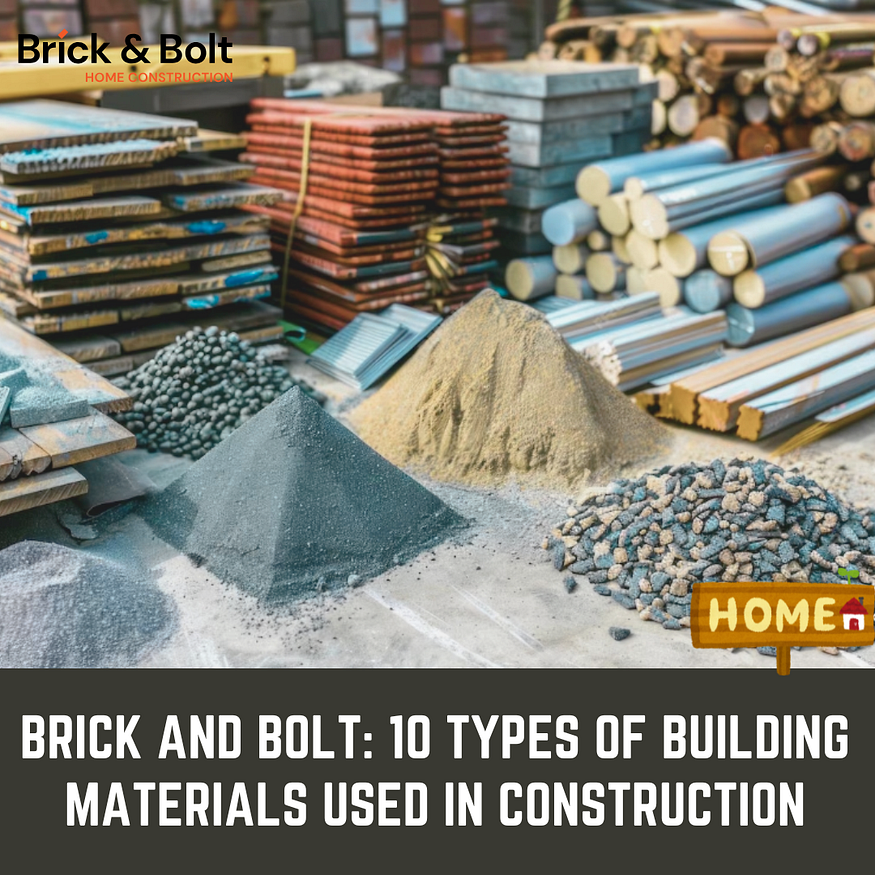Brick And Bolt: 10 Types of Building Materials Used in Construction

Brick And Bolt: In the construction industry, choosing the right building materials is essential for creating durable, functional, and sustainable structures. The materials used not only affect the overall look and feel of a building but also its strength, insulation, and longevity. Whether you’re constructing a residence or a commercial building, selecting high-quality materials is key to ensuring that the structure meets safety standards and environmental expectations.
In this blog, we will explore 10 types of building materials commonly used in construction. These materials vary in terms of cost, strength, and application, but all play a crucial role in the building process. Brick & Bolt is a trusted name in the industry, known for its high-quality materials and expert construction services.
Types of Building Materials Used in Construction
- Structural Materials:
Structural materials refer to the materials that form the main framework and shell of a building. They provide strength and durability, while ensuring protection and shelter from external forces.
1. Concrete
Concrete is one of the most widely used building materials in construction due to its strength, durability, and versatility. It is commonly used for foundations, floors, walls, and ceilings. Concrete is made from a mixture of cement, water, and aggregates (sand, gravel, or crushed stone).
Concrete offers excellent compressive strength, making it ideal for supporting heavy loads. It can also be molded into any shape, allowing for great flexibility in design. Moreover, with advancements in technology, reinforced concrete, which includes steel reinforcement, has become even stronger and more durable.
2. Brick
Bricks are another popular building material, known for their aesthetic appeal and strength. They have been used for centuries in construction and continue to be a preferred material for walls and facades in both residential and commercial buildings.
Made from clay, bricks are fired in kilns to achieve their hard and durable properties. They offer great insulation against temperature extremes, are fire-resistant, and have high compressive strength. Today, bricks are available in various sizes, shapes, and colours, allowing for creative and attractive designs.
3. Steel
Steel is a strong, flexible, and durable material used in modern construction. It is commonly used for framing large buildings, bridges, and other heavy structures. Steel is highly resistant to extreme weather conditions and has an excellent strength-to-weight ratio, making it ideal for tall buildings and skyscrapers.
Additionally, steel is fire-resistant and recyclable, making it an eco-friendly material. With advancements in technology, steel can be engineered to meet specific structural requirements, further enhancing its usefulness in various construction applications.
4. Wood
Wood is one of the oldest and most traditional building materials. It is widely used for framing homes, flooring, and furniture, and its natural beauty adds warmth to any space. Wood is lightweight, easy to work with, and a renewable resource when sourced sustainably.
In addition to its aesthetic appeal, wood provides good insulation, soundproofing, and is generally more energy-efficient than other materials. However, wood can be vulnerable to pests, rot, and fire, so proper treatment and care are essential for ensuring its longevity in construction.
5. Glass
Glass is primarily used for windows, doors, and facades, allowing natural light to enter a building while providing aesthetic appeal. Modern glass materials, such as tempered glass and double-glazed windows, offer additional benefits like better insulation and energy efficiency.
Glass can be incorporated into buildings to create transparent or reflective surfaces, and it is often used to provide stunning views or add modern flair to a structure. Moreover, the use of glass in construction promotes energy efficiency by improving natural lighting and reducing the need for artificial light during the day.
6. Cement
Cement is the binding agent used to create concrete. It is made from a mixture of limestone, clay, shells, and silica and is an essential material for most construction projects. Cement is highly versatile and is used to bind together other materials like sand and gravel to form concrete, mortar, and plaster.
Cement is valued for its strength and durability, and it is often used in the construction of foundations, walls, and roads. It also plays a key role in creating prefabricated building components like blocks, panels, and bricks.
- Finishing Materials:
These are materials that are added onto the structural materials and form the final finish that we see in a building. Although they are also used for their strength and durability, the aesthetics of these materials are prioritised.
1. Stone
Stone has been used in construction for thousands of years due to its durability, strength, and natural beauty. It is commonly used for foundations, walls (where it is a structural material), cladding, and flooring in both residential and commercial buildings. Stones like granite, limestone, and marble are especially valued for their aesthetic appeal and longevity.
Stone provides excellent thermal mass, meaning it can absorb, store, and release heat effectively. This makes stone buildings naturally energy-efficient and comfortable in a variety of climates. It’s also fire-resistant and requires low-maintenance, making it ideal for long-lasting construction.
2. Aluminium
Aluminium is a lightweight, corrosion-resistant metal used in the construction of windows, doors, and facades. It is also used for structural components in both commercial and residential buildings due to its high strength-to-weight ratio.
Aluminium is a popular choice for modern buildings because of its sleek appearance and low maintenance requirements. It’s also highly recyclable, making it an eco-friendly option. Moreover, aluminium can be molded into different shapes and sizes, offering flexibility in design.
3. Polymer Materials
Polymer materials, such as plastics and composites, are becoming increasingly popular in construction due to their lightweight nature, versatility, and resistance to weather conditions. These materials are often used in roofing, insulation, windows, and even flooring.
Polymer materials are highly resistant to water, corrosion, and UV radiation, making them suitable for a wide range of applications. Additionally, they can be molded into complex shapes, offering a high degree of design flexibility.
4. Insulation Materials
Insulation materials are crucial for maintaining energy efficiency in buildings. These materials reduce heat transfer between the inside and outside of a building, helping to maintain a comfortable indoor temperature throughout the year. Common insulation materials include fiberglass, foam boards, cellulose, and spray foam.
Good insulation not only helps reduce energy consumption but also improves soundproofing and contributes to a healthier indoor environment. Proper insulation is essential for both residential and commercial buildings to ensure comfort, reduce energy bills, and support sustainability.
Conclusion
Choosing the right building materials for your construction project is crucial to ensuring the durability, efficiency, and aesthetics of the final structure. Each material offers its own set of benefits, from the strength of concrete and steel to the natural beauty of wood and stone.
For construction companies like Brick & Bolt, selecting the best materials for each project is essential in delivering high-quality, durable, and sustainable buildings. Whether you’re building a home, office, or commercial space, the right building materials will provide the foundation for a strong and lasting structure.


Comments
Post a Comment